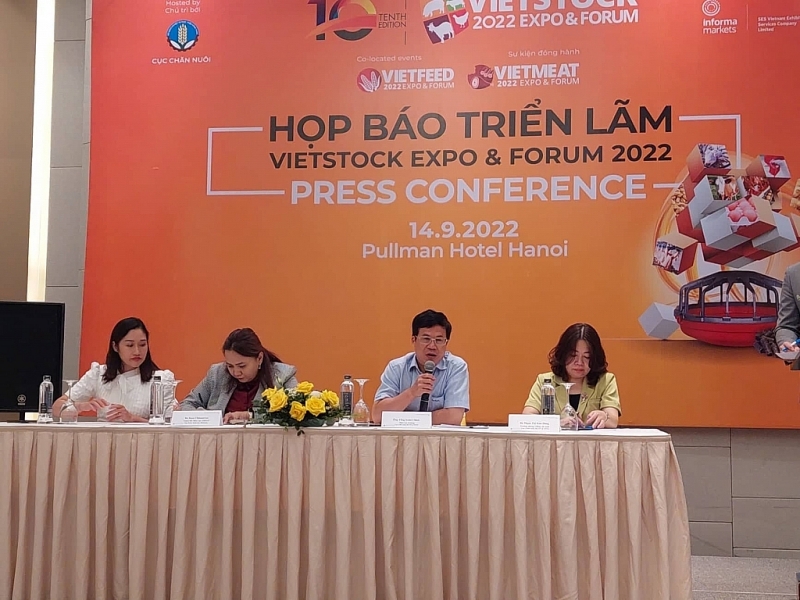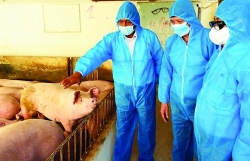 |
| Overview of the press conference |
According to statistics of the General Department of Customs, in the first seven months of 2022, Vietnam exported 10,490 tons of meat and meat products, worth $41.85 million, down 4.5% in volume, but up 3.3% in value over the same period in 2021. In July 2022, Vietnam’s meat and meat products were mainly exported to the markets of Hong Kong (China), Thailand, Belgium, the USA, Laos, Spain.
Speaking at the press conference to announce Vietstock 2022 Exhibition and Conference (Vietnam’s leading international trade exhibition on livestock, feed and meat processing industry) organized by Exhibition Services Company SES Vietnam (under Informa Markets Group) held on September 14, Mr. Tong Xuan Chinh, Deputy Director of the Department of Livestock Production (MARD) said that over the years, the livestock industry has developed rapidly.
The development of the industry is largely contributed by the private sector system, especially enterprises. In the livestock industry, there have appeared many value chains, even closed value chains of large corporations such as CP Group, TH Group, Dabaco Group.
Enterprises both produce animal feed, produce seeds, raise livestock, and slaughter. Notably, many businesses are trying to meet the requirements of the importing country to boost the export of their products, such as exporting chicken products, and exporting milk.
Answering a question from a reporter of Customs News about the opportunity to speed up the export of livestock products, the leader of the Department of Livestock Production said in the livestock industry, there is a tendency to invest in a closed value chain, meeting the standards, taking advantage of opportunities to boost exports to markets that have free trade agreements (FTAs).
Vietnam has now signed 17 FTAs, including prominent FTAs such as the Comprehensive and Progressive Agreement for Trans-Pacific Partnership (CPTPP), the Vietnam-EU FTA (EVFTA). This creates great opportunities for Vietnam to export products, including livestock products.
In order to make good use of opportunities and promote exports, livestock products must meet regulations on animal quarantine. Exporting livestock products, there is usually an agreement on animal quarantine between Vietnam and other countries.
“At the same time, it is necessary to meet regulations on food quality and safety and regulations and requirements on the environment and animal welfare in the process of raising, slaughtering and transporting,” Mr. Tong Xuan Chinh said.
Regarding the animal welfare factor, Mr. Chinh said the EU stipulates that each chicken must have a space of 8cm that is enough for the chicken to poke its neck out to peck the food on the tray. For enterprises that want to export poultry products to the EU, the entire system of cages must be checked to see if it meets animal welfare regulations.
Currently, the Law on Veterinary Medicine has the first regulation on animal welfare. At the same time, the Law on Livestock also has four articles related to animal welfare.
It emphasizes that usually large enterprises producing in chains can meet and take advantage of the export potential, Mr. Chinh analyzed, in addition to the factors mentioned above, export products also have to compete on price.
In exporting pork products to the US, the current price of Vietnam is nearly US$3/kg of live weight, while in the US the price of live hog is US$1.1/kg. This is a huge competition problem, it takes a lot of investment and a methodical system to meet the criteria.
“It is believed that with the methodical investment of corporations such as CP Group, TH Group, Dabaco Group, Vietnamese livestock products can meet the requirements of importing countries,” said the Director of the Department of Livestock.
Mr. Tong Xuan Chinh mentioned the issue of attracting investment in the livestock sector. According to the Foreign Investment Agency (Ministry of Planning and Investment), in the past five years, there have been 81 FDI projects in the livestock sector with a total investment capital of about $2.2 billion in various fields such as livestock direct farming, slaughter, processing, and environmental treatment.
In which, the largest investment focuses on the closed livestock chain from farm to table. This is also an inevitable trend in the world, because so these stages can compensate for each other.
 | Increase in the price of imported materials puts the livestock industry in a difficult position |
If one business is not strong enough to do all the chains, Mr. Chinh thinks that it is possible to link many businesses to create a closed chain. However, if a joint venture is to close the value chain, there must still be one enterprise that plays the role of “leader”, leading, managing and supervising the entire chain to be successful.
